What are the hydroponic flowers? Hydroponic flower technology Hydroponic flower pictures
Hydroponic flowers are a new generation of high-tech agricultural projects. Compared with traditional flower cultivation methods, hydroponic flowers have the advantages of cleanliness, hygiene, convenient maintenance, and reusability. They are very suitable for indoor cultivation. This cultivation method is very popular among the public. So what is the technology of hydroponic flowers? Do you know what hydroponic flowers are there? Let's follow the editor to find out!
Hydroponic flower pictures-what are the hydroponic flowers and
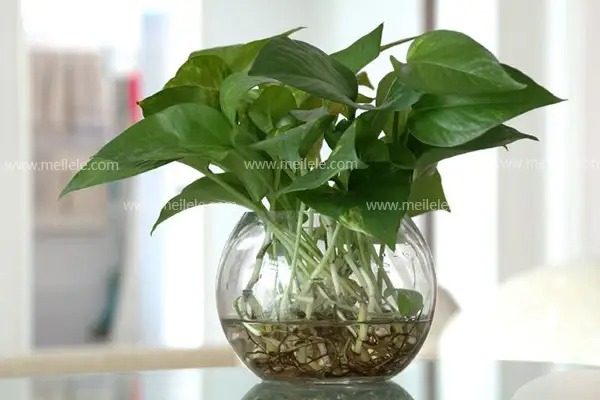 what flowers are suitable for decoration? More latest plant consultation!
what flowers are suitable for decoration? More latest plant consultation!
Generally speaking, most plants can be hydroponic flowers, such as our common carnations, monster bamboo, Milan, Clivia, camellia, asparagus, African daisy, tulip, hyacinth, chrysanthemum, calla lily, gloxinia, cyclamen, rose, gladiolus, orchid, Dieffenbachia, Brazilian wood, Hulk, Schefflera, jasmine, azalea, golden sycamore, violet, Phalaenopsis, fuchsia , five-needle pine, banana, rubber fig, Brazilian iron, begonia, ferns, palm plants and some bonsai flowers, etc., the hydroponic effect is relatively good.
In addition to the types of hydroponic flowers mentioned above, there are also various foliage plants that can be hydroponically cultivated, such as the Araceae family's clustered spring taro, silver-wrapped taro, anthurium, Guangdong spider plant, and silver-edged dieffenbachia; the Sedum species' lotus palm, hibiscus palm, and other species' Clivia, Paphiopedilum, Christmas cactus, lucky bamboo, hanging pineapple, Cineraria, Brazilian wood, ivy, coleus, and more than 100 other flowers.
Hydroponic flower pictures - Hydroponic flower technology
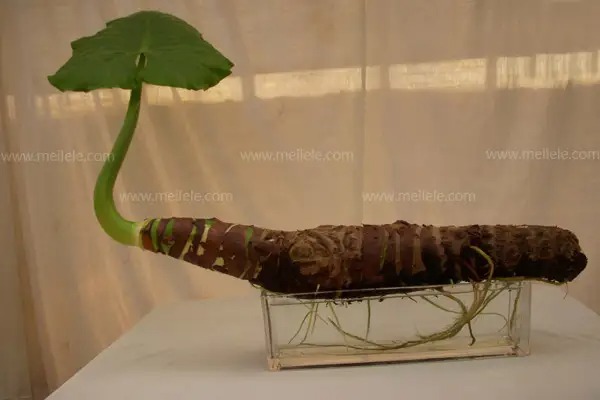
1. Pay attention to the stage
From the perspective of the plant growth cycle, there are two technical stages in hydroponic flower technology that need to be paid attention to: one is the seedling cultivation stage, that is, the water propagation process; the other is the plant product care stage, that is, the personal operation of the hydroponic process after the hydroponic success. Through the maintenance work of these two stages, following the correct hydroponic rules, and paying attention to the problems that need to be paid attention to during the cultivation process, we can see beautiful, elegant, clean and healthy hydroponic flowers.
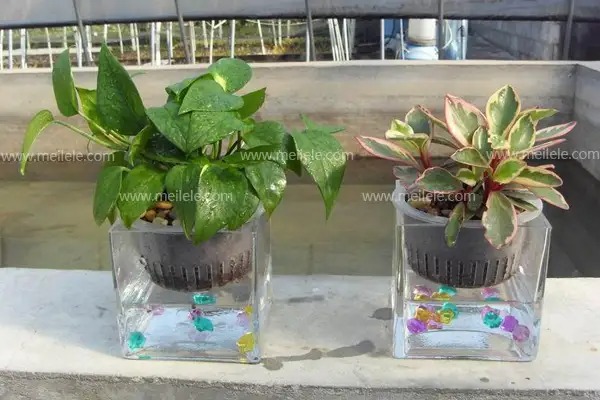
2. Soilless acclimatization
(1) Planting of large seedlings: Tap the sides of the flower pot with your hands , and remove the whole plant from the pot after the soil is loosened. Gently remove the dirt with your hands, or rinse it directly with water; then cut the planting basket. If the head of the plant is too large and the hole diameter of the planting basket is too small, the hole of the planting basket needs to be enlarged to facilitate planting. Then add the prepared nutrient solution to the container, insert the roots of the large seedlings from the planting basket, and then fix it with a sponge or stone, etc., and be careful not to damage the roots.
(2) Planting of small seedlings: Planting of small seedlings is much simpler than planting of large seedlings. Generally, the seedlings are no more than 8 cm. Take the seedlings directly out of the pot and wash the roots slightly in water. Be careful not to accidentally damage the roots; then start planting the seedlings, insert the roots of the seedlings directly from the holes of the planting basket, and fix them with stones.
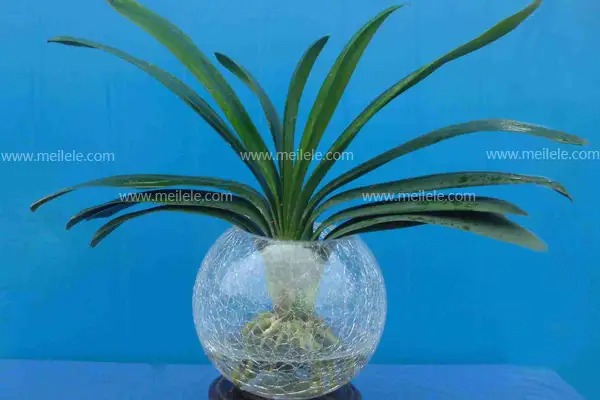
(3) Blending of nutrient solution: Regarding the blending of nutrient solution for hydroponic flowers, you can go to a chemical reagent store to purchase and prepare it according to the formula provided in the relevant information; you can also use urea and other fertilizers to prepare it according to the local fertilizer source conditions, and use it in hydroponic flowers after gaining experience. The total concentration of other fertilizers should be controlled at 0.1%-0.2%.
(4) Key points for transplanting flowers: The water level of hydroponic flowers must be controlled well, and it should be low rather than high. Just keep the roots of the plants in the water, or even less. This state should be maintained for a month of adaptation, and then gradually increase the amount of water. During the hydroponic process, when water droplets appear on the tips of the leaves of the flowers, it is necessary to appropriately lower the water level of the hydroponic culture, and when hydroponic culture is just started, be careful to avoid direct sunlight.
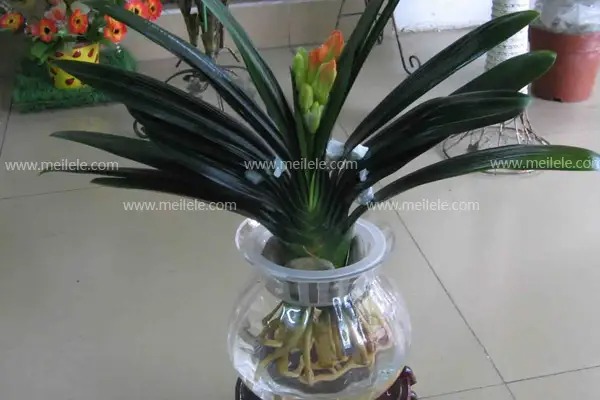
3. Soilless trough cultivation
(1 ) Establishment and method of water-based cultivation seedling bed: The water-based seedling bed should not leak. It is usually made of concrete or bricks with a thin film on the edge. It is about 1.2-1.5 meters wide and the length depends on the scale. It is best to build a stepped seedling bed to facilitate water flow and maintain the oxygen content in the water. Lay electric heating wires at the bottom of the bed to keep the water temperature stable at 21-25℃. Water-based cultivation can be carried out all year round. The water temperature should be controlled at around 25℃, not too high or too low. When water-based cultivation, plant seedlings should be inserted shallowly, with water or nutrient solution 5-8 cm in the bed. However, in order to keep the seedlings stable, clean sand can be placed at the bottom, or holes can be drilled in styrofoam boards, or a grid can be set up on the water surface. The plant seedlings can be inserted on the boards and placed in the water. During the rooting process, a water pump is used to circulate the water regularly every day to keep the water oxygenated.
(2) Preparation of nutrient solution commonly used for hydroponic seedlings: Hydroponic seedlings use water as a medium. Water does not contain any nutrients required for plant growth, so a certain nutrient solution must be prepared to provide the nutrients needed for plant rooting and seedling growth before transplantation. The selection of nutrient solution formula is the key to successful hydroponic seedlings, and different plants require different nutrient solution formulas, so when we perform hydroponics, we must prepare the nutrient solution according to the needs of the plants.
Article source: Home Decorations
Gardening
Flower Gardening
Hydroponic flower pictures-what are the hydroponic flowers and
 what flowers are suitable for decoration? More latest plant consultation!
what flowers are suitable for decoration? More latest plant consultation!Generally speaking, most plants can be hydroponic flowers, such as our common carnations, monster bamboo, Milan, Clivia, camellia, asparagus, African daisy, tulip, hyacinth, chrysanthemum, calla lily, gloxinia, cyclamen, rose, gladiolus, orchid, Dieffenbachia, Brazilian wood, Hulk, Schefflera, jasmine, azalea, golden sycamore, violet, Phalaenopsis, fuchsia , five-needle pine, banana, rubber fig, Brazilian iron, begonia, ferns, palm plants and some bonsai flowers, etc., the hydroponic effect is relatively good.
In addition to the types of hydroponic flowers mentioned above, there are also various foliage plants that can be hydroponically cultivated, such as the Araceae family's clustered spring taro, silver-wrapped taro, anthurium, Guangdong spider plant, and silver-edged dieffenbachia; the Sedum species' lotus palm, hibiscus palm, and other species' Clivia, Paphiopedilum, Christmas cactus, lucky bamboo, hanging pineapple, Cineraria, Brazilian wood, ivy, coleus, and more than 100 other flowers.
Hydroponic flower pictures - Hydroponic flower technology

1. Pay attention to the stage
From the perspective of the plant growth cycle, there are two technical stages in hydroponic flower technology that need to be paid attention to: one is the seedling cultivation stage, that is, the water propagation process; the other is the plant product care stage, that is, the personal operation of the hydroponic process after the hydroponic success. Through the maintenance work of these two stages, following the correct hydroponic rules, and paying attention to the problems that need to be paid attention to during the cultivation process, we can see beautiful, elegant, clean and healthy hydroponic flowers.

2. Soilless acclimatization
(1) Planting of large seedlings: Tap the sides of the flower pot with your hands , and remove the whole plant from the pot after the soil is loosened. Gently remove the dirt with your hands, or rinse it directly with water; then cut the planting basket. If the head of the plant is too large and the hole diameter of the planting basket is too small, the hole of the planting basket needs to be enlarged to facilitate planting. Then add the prepared nutrient solution to the container, insert the roots of the large seedlings from the planting basket, and then fix it with a sponge or stone, etc., and be careful not to damage the roots.
(2) Planting of small seedlings: Planting of small seedlings is much simpler than planting of large seedlings. Generally, the seedlings are no more than 8 cm. Take the seedlings directly out of the pot and wash the roots slightly in water. Be careful not to accidentally damage the roots; then start planting the seedlings, insert the roots of the seedlings directly from the holes of the planting basket, and fix them with stones.

(3) Blending of nutrient solution: Regarding the blending of nutrient solution for hydroponic flowers, you can go to a chemical reagent store to purchase and prepare it according to the formula provided in the relevant information; you can also use urea and other fertilizers to prepare it according to the local fertilizer source conditions, and use it in hydroponic flowers after gaining experience. The total concentration of other fertilizers should be controlled at 0.1%-0.2%.
(4) Key points for transplanting flowers: The water level of hydroponic flowers must be controlled well, and it should be low rather than high. Just keep the roots of the plants in the water, or even less. This state should be maintained for a month of adaptation, and then gradually increase the amount of water. During the hydroponic process, when water droplets appear on the tips of the leaves of the flowers, it is necessary to appropriately lower the water level of the hydroponic culture, and when hydroponic culture is just started, be careful to avoid direct sunlight.

3. Soilless trough cultivation
(1 ) Establishment and method of water-based cultivation seedling bed: The water-based seedling bed should not leak. It is usually made of concrete or bricks with a thin film on the edge. It is about 1.2-1.5 meters wide and the length depends on the scale. It is best to build a stepped seedling bed to facilitate water flow and maintain the oxygen content in the water. Lay electric heating wires at the bottom of the bed to keep the water temperature stable at 21-25℃. Water-based cultivation can be carried out all year round. The water temperature should be controlled at around 25℃, not too high or too low. When water-based cultivation, plant seedlings should be inserted shallowly, with water or nutrient solution 5-8 cm in the bed. However, in order to keep the seedlings stable, clean sand can be placed at the bottom, or holes can be drilled in styrofoam boards, or a grid can be set up on the water surface. The plant seedlings can be inserted on the boards and placed in the water. During the rooting process, a water pump is used to circulate the water regularly every day to keep the water oxygenated.
(2) Preparation of nutrient solution commonly used for hydroponic seedlings: Hydroponic seedlings use water as a medium. Water does not contain any nutrients required for plant growth, so a certain nutrient solution must be prepared to provide the nutrients needed for plant rooting and seedling growth before transplantation. The selection of nutrient solution formula is the key to successful hydroponic seedlings, and different plants require different nutrient solution formulas, so when we perform hydroponics, we must prepare the nutrient solution according to the needs of the plants.
Article source: Home Decorations